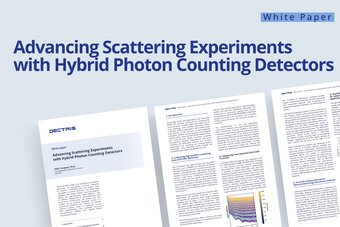The complicated story of antibodies in COVID-19
The new coronavirus has brought much of the world to a standstill, but research is progressing furiously. Only a few weeks after the virus appeared in patients in Wuhan, its structural components, proteins, were characterized, giving the first insights on how the virus works and how we can fight it. By now, structural biologists have determined more than 160 structures of nine different viral proteins, the vast majority of them by X-ray crystallography. This article focuses on just one structure – a part of the coronavirus spike protein bound to an antibody [1-4].


Figure 1. The unprecedented speed of macromolecular X-ray crystallography relies on technological progress. One of the key aspects is the detection technology, allowing for a fast and reliable data collection at synchrotron beamlines, such as beamlines 17U1 at SSRF (top, credit: Qisheng Wang, SSRF) and 14.2 at BESSY-II (bottom, credit: Christian Feiler, Helmholtz-Zentrum Berlin).
Antibodies are the hottest ticket in the fight against coronavirus. They give hope to stop the spread of the virus in two scenarios: herd immunity and vaccine development. Herd immunity means that a sufficient number of infection survivors have acquired immunity to the virus. At the beginning of the SARS-CoV-2 pandemic, before precautionary measures were taken, each infected person passed the virus on to three others on average. If this number falls below one, the epidemic peters out. Protective measures like social distancing, hand washing, and the wearing of face masks can achieve this. Herd immunity has the same effect, but without imposing restrictions. Vaccines, on the other hand, confer immunity without infection.
Vaccine development
The critical part of SARS-CoV-2 is its spike protein. It recognizes a human protein that coats the insides of the nose and the cells of our lungs. We know the details of this interaction from protein crystallography. When the two proteins bind, the spike protein changes shape, which causes the cell to engulf the virus. It can then replicate, infect neighboring cells and tissues, and seriously damage the lung and many other organs. 270'000 people have already died of COVID-19, the disease caused by SARS-CoV-2.
The spike protein, which protrudes from the lipid shell of the virus, is the principal target of vaccine design. If the human immune system were primed to recognize and counteract the spike protein, the infectivity of the virus would be much reduced and maybe even eliminated. Priming of the immune system is achieved by vaccination, and many research groups and pharmaceutical companies are pushing hard to develop vaccines against SARS-CoV-2. Human trials with candidate vaccines have already started in the UK, China and Germany.
A vaccine contains parts of a pathogen, such as a virus, packed in a harmless carrier. The immune system recognizes the vaccine as foreign, which triggers an immune response. The resulting protective antibodies keep cycling in the blood stream. A later infection, caused by a real virus, is then immediately detected and successfully fought off by the immune system.
Vaccines against viruses are often composed of viral proteins or nucleic acids encoding such proteins. These proteins evolved to let the virus survive and propagate. To be good vaccines, they might need modifications to enhance their stability, to have them bind better to antibodies and to prevent cross-reactions with human proteins. These modifications can be designed only if the proteins' molecular structures are known. With SARS-CoV-2, we have already three structures of parts of the spike protein bound to antibodies.
More than 100 vaccine studies are currently underway. One candidate, developed at Oxford University, can protect rhesus monkeys from coronavirus infection. If these results hold up in human trials, there will be cause for hope. A vaccine will nevertheless not be released any time soon because safety tests and regulatory approval tend to take much longer than the development of the vaccine itself. The vaccine must not cause more harm than the infection it prevents.
Herd immunity and antibody testing
Herd immunity hinges not on enough people getting infected but on them mounting a lasting immune response. The only way of knowing the degree of immunity in a population is to test a sample and then to extrapolate the results. If immunity is widespread, restrictions, such as stay-at-home orders, can be eased. SARS-CoV-2 is thought to cause a large number of asymptomatic infections. Determining the correct number of previously infected people requires accurate antibody tests.
Antibody tests have been developed by a large number of companies, but their reliability is not without a doubt. One of the main problems is that with a low incidence of what one is testing, the error rate of the test has to be exceptionally small to yield reliable results. If coronavirus has spread to less than 10% of a population, even a test that is more than 90% accurate yields up to 50% false positives. Up to half of those tested as having protective antibodies do not have them. This is basic statistics and should dampen our hopes for a system where those who test positive for coronavirus antibodies are allowed to live with fewer restrictions than the rest.
The other practical problem with the theoretical power of antibodies is that if they do not persist in survivors, herd immunity is impossible to reach. A study from China found antibodies against the spike protein in most confirmed COVID-19 survivors but reported low to undetectable counts in nearly 30% of them [5]. With such numbers, the hope to reach herd immunity soon might be misplaced. It might also be difficult to achieve lasting immunity with a vaccine that targets the spike protein. More research is dearly needed to understand the virus better.

Figure 2. Structural studies of SARS-CoV-2 proteins are critical for vaccine and drug development. More than 140 structures were determined with data collected with PILATUS and EIGER detectors at 14 synchrotron beamlines and in two laboratories. Ten archetypes are shown here.
Conclusion
Antibodies hold great promise for our defense against the new coronavirus. They are generated by the immune system upon infection, but can also be triggered by vaccination. Both are aspects of the same biological system and result in immune individuals and eventually a population resistant to SARS-CoV-2. Structural biology has laid the foundations for getting an effective vaccine. Without structures, the development process would be much slower, and it would take much longer for us to reach a state where SARS-CoV-2 is essentially under control.
References
1. Yuan et al., Science. 368, 630-633 (2020)
2. Pinto et al., bioRxiv. (2020)
3. Huo et al., bioRxiv. (2020)
4. Chi et al., bioRxiv. (2020)




